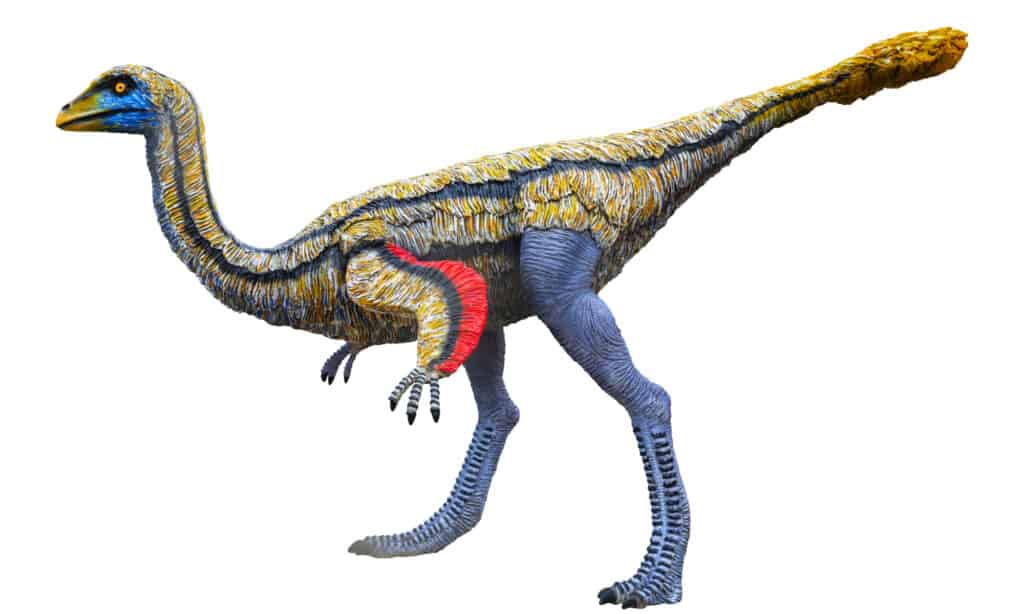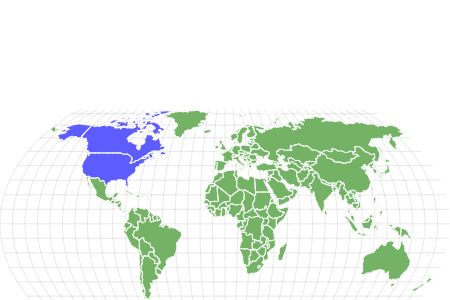Ornithomimus
Ornithomimus translates from Greek to mean “bird mimic.”
Advertisement
Ornithomimus Scientific Classification
Read our Complete Guide to Classification of Animals.
Ornithomimus Conservation Status
Ornithomimus Facts
- Fun Fact
- Ornithomimus translates from Greek to mean “bird mimic.”
- Most Distinctive Feature
- Grey or blue feathers; pink and black beak with inner ridges; curved neck
- Diet
- Omnivore
Ornithomimus Physical Characteristics
- Skin Type
- Feathers
- Height
- 7 feet
- Length
- 12 feet
- Age of Sexual Maturity
- 370 lbs.
View all of the Ornithomimus images!
Description & Size of the Ornithomimus
Ornithomimus is a genus of ornithomimid dinosaur, and its name translates from Greek to mean “bird mimic.” As you imagine what you think of a dinosaur, you’ll be surprised to find that the Ornithomimus looks nothing like it. Compared to other dinosaurs, the Ornithomimus was a medium-sized animal. When standing upright, the Ornithomimus measured 7 feet tall, though it was also 12-15 feet long (including the tail). Current specimens suggest that it weighed 370 lbs., featuring large eyes and a large brain within its small head. Scientists believe that the reason they had such a large brain had to do with the need for kinesthetic coordination. However, it had a poor sense of smell, focusing primarily on its excellent eyesight to find threats, seek out food, and protect itself.
The wrinkled pink and black beak separate it from other theropods (“bird mimic” dinosaurs). However, this is not the only separation from the typical therapod that the Ornithomimus had. Based on current research, they also had long arms and hands with curved necks. Their beaks were positioned towards the front of the head with ridges that look much like the inside of a goose or duck’s mouth. They are closely associated with the duck, rather than the much larger ostrich it is compared to.
It ran on two legs, using its two arms to grasp and hold. The feet had three toes that they used for balance, though their entire skeleton is made of hollow bones. Based on the strong structure and shape of the legs, they were likely great runners. The hands, on the other hand, look much like the hands of today’s sloths, leading American paleontologist Henry Fairfield Osborn to guess that they were used to hook onto their food. Despite having long legs, they had a short torso and an overall slender body.
Covered in light blue scales, there is no major pattern associated with the Ornithomimus. Most of their head and necks were much brighter blue, while the body is covered in grey instead. Though uncommon, some specimens had speckling along their scales as well. Males were frequently more colorful, while females took on a greyer appearance.
Originally, scientists believed that the Ornithomimus was entirely covered in scales, but studies in 1995 told a different tale. Instead, new specimens in 1995, 2008, and 2009 showed fossils that were preserved with feathers intact, creating hair-like feathers along their legs, neck, and lower torso. Wing-like structures were found in adults, suggesting that they might’ve been used as a way to attract a mate. The first specimen to be found with both feathers and a tail was not recorded until 2015 by Aaron van der Reest, Alex Wolfe, and Phil Currie.
Based on what we know about their offspring, it was likely that this dinosaur started with downy feathers which only lasted until their first molting as an adult. They had a muted brown color for these feathers, which were complemented by proto-feathers as well. It is believed that the wings did not develop until the dinosaur reached sexual maturity, at which time they were used to either attract a mate or scare off any potential predator and to keep their eggs and hatchlings warm as they grow.
Diet – What Did the Ornithomimus Eat?
What did the Ornithomimus eat? For the most part, the Ornithomimus had an herbivorous diet, but recent research suggests that they were more of opportunistic omnivores. Their typical diet included both plants and meat, going after small reptiles and mammals. They also sought out the eggs of other animals for further nutrients.
Even with the information currently available, scientists continue to debate what the Ornithomimus actually ate. Their shape suggests that their primary diet was herbivorous, but the classification of an ornithomimid suggested that it was more herbivorous. In addition to the meat they sought, they also consumed leaves, crustaceans, and more.
The main reason that researchers haven’t been able to narrow down their diet is because the Ornithomimus has no teeth. Ornithomimid skeletons have been found with grounded stones in their stomach, suggesting that it was used to grind up food during digestion in the same way that lots of modern birds do. So far, the exact plant material included in their diet has not been determined.

©YuRi Photolife/Shutterstock.com
Habitat – When and Where the Ornithomimus Lived
The late Cretaceous Period in North America was the best place to find the toothless Ornithomimus. While the majority of this species was found in the United States, researchers have placed just one species in Canada in the Horseshoe Canyon Formation – Ornithomimus edmontonicus. However, it is possible that this specimen relates to a different species.
Ornithomimus was not seen alone. Instead, they lived with a flock that usually had at least 20 other dinosaurs in a social environment. While one adult Ornithomimus would be in charge of keeping watch, the others waited for their turn while feeding and playing. This role allowed them to be warned of incoming predators and other threats wherever they lived.
Their habitat determined how well they could care for their young. While females would make a nest separately from the group, they were still quite protective. To support their young, they would live near lakes and ponds, shying away from forests. They seemed to prefer the coastal plains near the Western Interior Seaway. This sea originally connected the Arctic Ocean and the Gulf of Mexico, separating one side of North America from the other.
Over the last several million years, the changes in sea levels and climate fluctuations have drastically changed this inland sea. Though once a humid wetland with forested landscapes, this area of the country is home to plains and even desert areas.
Threats And Predators of the Ornithomimus
The main predators of the Ornithomimus were the Dromaeosaurs and the Tyrannosaurus. However, the Ornithomimus had one main characteristic on their side when a predator was in pursuit – their speed. With strong and muscular legs, the Ornithomimus could reach speeds of 40 mph or higher, which is about the same speed as an ostrich. While they could run incredibly fast, not all of them managed to escape the grips of apex predator dinosaurs.
Even though the Ornithomimus would live within a herd, the presence of a threat would send them into a stampede of disorganization and chaos to get away. The herds consisted of predominantly young Ornithomimus individuals with a few older ones.
Discoveries and Fossils – Where the Ornithomimus Found
Like many dinosaurs, the Ornithomimus was named by Othniel Charles Marsh in the late 1800s. It was first identified with just its foot and a partial hand, setting up the overall species and genus. It was originally located in Colorado at the Denver Formation. At the time of the discovery, Marsh managed to name two other species within the genus, using fragmentary fossils that were discovered in Montana by John Bell Hatcher.
When any ornithomimid was discovered, researchers automatically placed it under the Ornithomimus genus. This pattern can be seen around the world through the 1960s, creating a lot of confusion over the classification of the different species. To clarify, Dale Russell published a study in 1972 to explain the significant differences, creating two new genera.
Even after Russell’s study was published, many researchers continued to put the since-reassigned species back into the genus for various reasons, even after the year 2000. In fact, researchers Peter Makovicky, Yoshitsugu Kobayashi, and Phil Currie all dismissed Russell’s statements, saying that there was no reason to separate the Ornithomimus from the genus Dromiceiomimus.
Though it was first found in the United States, the best specimen on record was found in Alberta, Canada. The majority of specimens can now be seen in museums in North America. The first specimen found in Canada was discovered by a paleontologist named Lawrence Lambe. It was located in the modern Dinosaur Provincial Park.
Most of the specimens that paleontologists have discovered have the same “death pose,” which presents as the neck and tail curled over the body with their arms and legs tucked in. This posture was most common if the specimen was underwater.
Extinction – When Did the Ornithomimus Die Out?
Based on the time period that the Ornithomimus lived, it most likely went extinct around the same time that other dinosaurs did – around 65 million years ago. This event, which is known as the K-T extinction, is believed to have ended with the collision of a large asteroid into the earth. This change most likely killed off many species (including the rest of the dinosaurs) over 60 million years ago.
Though the K-T extinction brought the lives of most animals to an end, birds managed to largely survive.
Similar Animals to the Ornithomimus
Similar dinosaurs to the Ornithomimus include:
- Gallimimus – This therapod dinosaur lived near Mongolia during the Late Cretaceous period like the Ornithomimus. It stood 6.6 feet tall, and it was a little slower than other species under this genus.
- Oviraptor – Once thought of as an egg thief (which is the literal translation for its name), this species of dinosaur was omnivorous and quite doting over its young. It could crush almost any small object with its curved jaw, and it was originally discovered in 1923.
- Struthiomimus – The name of this dinosaur is Greek for “ostrich mimic.” It was a feathered animal with a small head and speedy legs, and it had a diet of animals, seeds, and fruit.
Ornithomimus FAQs (Frequently Asked Questions)
When was the Ornithomimus alive?
Based on the current specimens available, scientists believe that the Ornithomimus lived during the Late Cretaceous period about 65-76 million years ago. It met its end with the rest of the dinosaurs at the end of this period.
How big was the Ornithomimus?
The total length of the Ornithomimus was about 12 feet, standing 7 feet tall. They most likely weighed about 370 lbs.
Thank you for reading! Have some feedback for us? Contact the AZ Animals editorial team.
Sources
- Prehistoric Earth: A Natural History Wiki, Available here: https://prehistoric-earth-a-natural-history.fandom.com/wiki/Ornithomimus
- Wikipedia, Available here: https://en.wikipedia.org/wiki/Ornithomimus
- ThoughtCo, Available here: https://www.thoughtco.com/gallimimus-1091800
- Wikipedia, Available here: https://en.wikipedia.org/wiki/Struthiomimus
- The Canadian Encyclopedia, Available here: https://www.thecanadianencyclopedia.ca/en/article/ornithomimus
- ThoughtCo, Available here: https://www.thoughtco.com/things-to-know-ornithomimus-1093793
- Britannica, Available here: https://www.britannica.com/science/K-T-extinction
- Britannica, Available here: https://www.britannica.com/animal/Ornithomimus

















